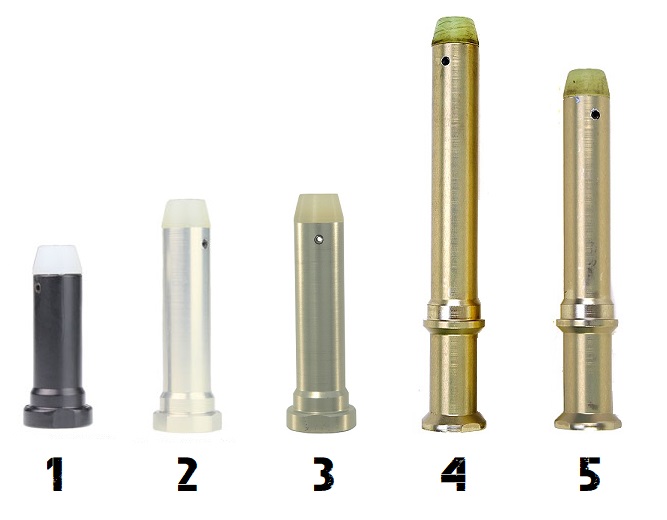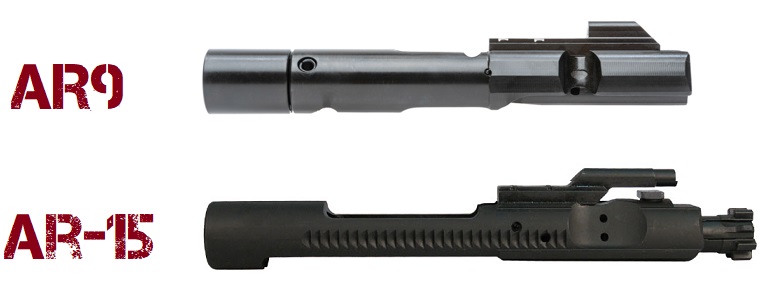The Guide to AR-15 Buffers & Weights
Posted by 80-Lower.com on Dec 19th 2019
Like the gas system, the AR-15's buffers play an important role in controlling recoil and, more importantly, assisting the bolt carrier group's travel so it can reliably cycle whatever ammunition you feed through your rifle, SBR, or pistol. Depending on your AR's configuration, you'll need to pick the right weight for your buffer assembly.
Go with a buffer that's too light, and you'll suffer from excessive recoil and extra wear-and-tear on your bolt, parts kit, and receiver. Too little weight may cause the bolt to unlock early, as well, resulting in a stuck casing. But throw a buffer in that's too heavy, and you'll run into failures to feed, jams, or short strokes. This guide covers the AR-15's numerous buffer weights and what's best for you, and we even dive into picking the right setup for building a 300 blackout AR, as well as the .308-chambered rifle. We'll also compare the modern carbine buffer to the original rifle buffer.
The Buffer System's Parts
The typical AR-15 buffer consists of an aluminum casing which houses the buffer's weights inside. The weights are made from steel or tungsten and are inserted inside the casing, separated by rubber pads. This mitigates the shock of recoil energy imparted on the buffer by the bolt carrier. The head of the buffer is capped by a bumper made of high-impact plastic. The bumper, held by a retaining pin, prevents the casing from taking damage when it bottoms out at the back of the buffer tube. The large base of the buffer directly contacts the back of the bolt carrier group.
Assembly: Exploded View

Assembled and ready for work, the buffer rests inside the recoil spring, with the spring wrapping around the casing. The buffer and spring rest inside the buffer tube, which is secured to the lower receiver via a castle nut and latch plate. Once fully assembled, the buffer and spring compress as the gas system forces the BCG into the tube. Once fully compressed, the spring and buffer rapidly decompress, forcing the BCG into the upper receiver to chamber another round.
AR-15 Buffer Weights
The weights inside the buffer matter most. Buffer weights are typically made from steel or tungsten. Different combinations of weights will produce the correct total weight required for your weapon's setup. Selecting the correct weight largely depends on your AR's gas system, whether you're firing conventional supersonic loads or lower-pressure subsonic loads (with or without a suppressor), and what types of cartridges you use most often.
Weight Classes
- Carbine (3.0 oz.)
- Heavy (3.8 oz.)
- H2 (4.7 oz.)
- H3 (5.0 oz.)
- HSS (6.5 oz.)
- XH (8.5 oz.)
These are the most common "standard" weights you'll find. Carbine, heavy, and H2 buffers make up the bulk of all buffer used by most AR builders and shooters.
What Weight's Best For My AR?
We scoured shooter's reports, forums, videos, and plenty of reference guides to figure out what buffer weight is best, depending on your gas system. Compare below to find the optimal buffer for your setup. It's important to know that gas port diameter can also affect which buffer is optimal for yourself. We listed gas port diameters in our Builder's Guide to AR Gas Systems.
Carbine Buffer: 3.0 ounces, (3) steel weights
The carbine buffer is best used with a mid-length gas system with a 16" barrel, in a traditional 5.56/.223 rifle setup. It may also be used with a carbine gas system, though felt recoil will be increased. Your AR-15 might feel "over-gassed" and punchy. If you're building an AR chambered in 300 Blackout, the carbine buffer should be used with subsonic ammo and a pistol-length gas system.
H Buffer: 3.8 ounces, (2) steel (1) tungsten
We like to call the Heavy, or "H", buffer the diagnostic buffer. It's what many shooters turn to if they're running a carbine buffer and their rifle's over-gassed, felt recoil is excessive, or the bolt unlocks too soon because the buffer's too light. The heavy buffer is also best used with a carbine or mid-length gas system in a standard 5.56/.223 rifle. It may also be used in a subsonic 300 Blackout gun equipped with a pistol gas system.
H2 Buffer: 4.7 ounces, (2) steel, (2) tungsten
The H2 buffer is usually the best buffer for a carbine gas system in a 16" rifle, cycling reliably with the least recoil possible. Most shooters report it works just fine with a mid-length setup, too. If you're building an AR pistol with a pistol-length gas system, you will want to stick with an H2 over an H or carbine buffer, though felt recoil may be high. The H2 buffer may fail to fully cycle in a rifle made to shoot subsonic 300 blackout, even with a pistol gas system equipped.
H3 Buffer: 5.0 ounces, (3) tungsten weights
The H3 buffer largely foregoes use in a standard 16"-barreled AR, and is instead typically used for 9" to 11" AR pistol builds running conventional 5.56 or .223 with a pistol-length gas system. Most shooters agree an H3 buffer is the minimum weight required to ensure your pistol doesn't feel punchy with excess recoil. Lastly, the H3 buffer is also frequently used in lieu of a conventional 9mm buffer for AR9 builds, which rely on blow-back to drive the bolt, as its buffer weight is similar. This produces even greater recoil energy inside the smaller 9mm BCG, requiring greater weight.
Important Note: AR9 bolt carrier groups are physically shorter than the AR-15's BCG. While the AR9 operates using an AR-15 buffer tube and spring, the shorter BCG means it will over-travel past the bolt catch with a typical AR-15-length buffer. Many shooter install spacers (with a total length of 0.76" to 0.875") behind the recoil spring to compensate for this over-travel. You can even stack U.S. quarters in the back of the tube in a pinch.
HSS Buffer: 6.5 ounces, custom weights
Just as the H2 buffer is meant to dampen recoil and energy over a carbine buffer in a punchy 5.56 rifle, the HSS buffer is intended to tame the AR9s that still feel over-gassed when using an H3 or by-design 9mm buffer. The HSS buffer uses custom weights (though still usually tungsten) with a stainless steel housing to add even more weight.
XH Buffer: 8.5 ounces, (5) steel, (1) spacer
The big-boy XH buffer is mostly used in high-energy 9mm AR pistols running +P ammo, or .308- and 6.5 Creedmoor-chambered rifles. At 8.5 ounces it weighs nearly three times that of a standard carbine buffer, making it unreliable in most 5.56 and .223 guns. Some shooters do run an XH buffer in 5.56 and .223 pistols, though this is most often because the pistol in question is using a large-diameter gas port.
Rifle vs. Carbine Buffer Lengths
The AR-15's original buffer is longer than the modern design (you can see it below in spot #4) and it requires a special buffer tube. This longer tube was only used in the M16 with its old fixed stock, before the smaller M4 Carbine was developed in the 1970s. All new, standard AR-15s use the modern short buffer.
"AR-10" (.308) vs. AR-15 Buffers & Tubes
All .308 80% lowers and finished lower receivers share the same buffer tube housing and threads with the AR-15. That means you can use an AR-15 buffer and tube on an LR-308 or AR-10 build, but you'll need the right tube and buffer combo to get the appropriate length of travel for the longer BCG and recoil spring. There are five buffers one can use in a .308 build:
.308-Compatible Buffers

From left to right, the following buffers will work in your .308 receiver and tube:
- DPMS .308 "shorty" buffer
- ArmaLite AR-10 carbine buffer*
- AR-15 carbine buffer
- AR-15 rifle buffer
- ArmaLite AR-10 rifle buffer
*ArmaLite's carbine buffer weighs the same as the AR-15's carbine buffer.
The following buffer tubes are available for use with a .308 build:
- Carbine / AR-15 (7.125")
- .308 / AR-10 (7.9375")
- M16 A2 / Rifle (9.625)
And finally, these are the rules of compatibility:
- The DPMS buffer must be paired with an AR-15 carbine tube.
- The AR-15 and ArmaLite carbine buffer must be used with a medium tube.
- The AR-15 and ArmaLite rifle-length buffer must be used with the rifle tube.
Q: What is the optimal buffer weight for an AR-308 or AR-10 build?
A: For .308 rifles using a mid-length gas system and carbine tube (the most common setup), a buffer weight of 3.8 ounces to 5.5 ounces works best.
AR9 Buffers: Overview & Best Practices
It's important to note the AR9's blow-back functionality requires a different bolt carrier group that ditches the carrier key and gas system entirely. This means the AR9 bolt is physically shorter than the AR-15's BCG:

Because of its shorter BCG, and because the AR9 can (and often does) use the same carbine buffer tube as the AR-15, the AR9 requires a physically longer buffer to compensate for the difference in BCG travel, unless a shorter tube or spacers are used instead.
AR9 Buffer FAQs
Q: Can I still use a regular AR-15 buffer (with the appropriate weight) and a carbine tube in my AR9?
A: Yes, but it is not recommended. The longer travel of the AR9 bolt can (and often does) break the bolt catch.
Q: What are symptoms of a poor AR9 buffer and tube setup?
A: The AR9's designed to function with LRBO, or last-round-bolt-open. This means the bolt remains locked to the rear once the magazine is emptied on the last shot. If your buffer and tube setup are incorrect, this will typically fail to occur.
Q: What if I want to use an AR-15 buffer and tube for my AR9 build?
A: This is perfectly acceptable, though you'll want to invest in an appropriate spacer. Again, the optimal spacer length is 0.76" to 0.875".
Q: What is the optimal buffer weight required for the AR9?
A: The AR9 buffer must weigh 5.0 ounces or more, to ensure reliability. A weight of 5.4 ounces is ideal.
DISCLAIMER: If you are new to the world of DIY gun building, you likely have a lot of questions and rightfully so. It’s an area that has a lot of questions that, without the correct answers, could have some serious implications. At GunBuilders.com, we are by no means providing this content on our website to serve as legal advice or legal counsel. We encourage each and every builder to perform their own research around their respective State laws as well as educating themselves on the Federal laws. When performing your own research, please be sure that you are getting your information from a reliable source.

